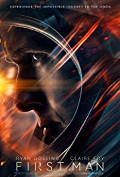
Directed by
Damien Chazelle
141 minutes
Rated PG
Reviewed by
Bernard Hemingway

First Man
Synopsis: A look at the life of Neil Armstrong (Ryan Gosling) and how he become the first man to walk on the Moon.
Although carrying across his leading man, Ryan Gosling, from his previous film, 2016’s Oscar-chomping musical, La La Land, Hollywood wunderkind Damien Chazelle’s follow-up film is a very different kettle of fish (or better, can of spam) and a vastly impressive one at that.
Picking up from where Philip Kaufman’s The Right Stuff (1983) left off (that film gets an explicit nod here by a small appearance for the iconic Chuck Yeager character) it charts Neil Armstrong’s story from his days as an Air Force test pilot to his historic small step onto the Moon on July 20, 1969 (assuming that you believe that that really happened). Although it doesn’t have the gorgeous high-end visuals of Alfonso Cuarón’s Gravity (2013) or the breadth of Stanley Kubrick’s 2001: A Space Odyssey (1968) what it does have is a superb sense of authenticity both in terms of giving us a front row view of NASA’s Kennedy-era space program and taking us into the lives of Armstrong and, by extension, that of his fellow astronauts.
In the technical department the film is, as they say, awesome. I can only suppose that somewhere NASA has huge warehouses full of mothballed memorabilia, from flight simulators, lunar landing craft and fight capsules to spacesuits in mint condition and that Chazelle was given access to this wealth of resources and the support to make it work.
Whereas with Kubrick’s film, indeed as is standard for the space travel genre, we got a idealized view of high-tech, futuristic sophistication, with First Man’s recreation of the Apollo program we get disconcertingly functionalist technology, apparently cobbled together out of existing engineering knowledge and subject to often deadly trial and error testing. One of the film’s convincingly-made points is that the skills required to “fly” these spacecraft were every bit as praiseworthy as was the case for the old school flyboys of The Right Stuff. This is brought home in the twinning of two bravura sequences – the opening in which Armstrong wrestles his test plane under control just at the outer envelope of the Earth’s atmosphere and the other in space when he has to do similarly during a test docking of his capsule. Cinematographer Linus Sandgren, who also lensed La La Land, does a superb job of giving these scenes all the vertiginous, bone-rattling tension that you could want, mercifully rewarded by the silent calm of survival. You cannot help but breathe a sigh of relief.
Josh Singer’s measured, insightful screenplay, based on James R. Hansen’s 2005 biography of Armstrong, makes passing reference to the Cold War, Vietnam and the Civil Rights movement (an impressive scene with Gil Scott-Heron reciting his poem ‘Whitey on the Moon’), but for the most part the focus is closely on the Apollo program and the "first man" in particular.
Armstrong, an emotionally-reserved, quietly methodical individual, is not the kind of character who you’d think would engage as the subject of a biopic but especially thanks to Gosling’s intensely internalized performance, easily the best of his career to date, he provides the focal point from which we observe the hurly-burly of the space race with its boys’ club mentality. The death of his infant daughter, Karen, from a brain tumor just before her third birthday, an incident which in some part contributed to his decision to apply for the space program, only serves to deepen his detachment from the world around him including his supportive wife, well played by Claire Foy who bring a fresh quality to what is a very familiar character type. All the support players including Jason Clarke, Olivia Hamilton, Patrick Fugit, Corey Stoll and Ciaran Hinds bring a similar understated quality to their small roles
Unlike the rest of the world I was not taken with La La Land but Chazelle’s follow-up, although ironically it will not get anywhere near the attention that its predecessor did, is a real achievement, a sensitively hands-on engagement with its subject realized with impressive across-the-board craftsmanship and not a trace of Stars and Stripes hyperbole.

Want more about this film?


Want something different?




